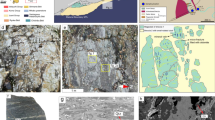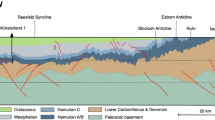Abstract
The right-bank slope of the Dagangshan hydropower station located in Southwest China is a highly unloaded rock slope. Moreover, large-scale natural faults were detected in the slope body; some excavation-induced unloading fractures were discovered at elevations between 1075m and 1146m. Because of poor tectonic stability, the excavation work was suspended in September 2009, and six largescale anti-shear galleries were employed to replace the weak zone in the slope body to reinforce the rightbank slope. In this study, based on microseismicmonitoring technology and a numerical-simulation method, the stabilities of the slope with and without the reinforcement are analysed. An in-situ microseismic-monitoring system is used to obtain quantitative information about the damage location, extent, energy, and magnitude of the rocks. Thus, any potential sliding block in the right-bank slope can be identified. By incorporating the numerical results along with the microseismic-monitoring data, the stress concentration is found to largely occur around the anti-shear galleries, and the seismic deformation near the anti-shear galleries is apparent, particularly at elevations of 1210, 1180, 1150, and 1120m. To understand the interaction mechanism between the anti-shear gallery and the surrounding rock, a 2D simulation of the potential damage process occurring in an anti-shear gallery is performed. The numerical simulation helps in obtaining additional information about the stress distribution and failure-induced stress re-distribution in the vicinity of the anti-shear galleries that cannot be directly observed in the field. Finally, the potential sliding surface of the right-bank slope is numerically obtained, which generally agrees with the spatial distribution of the in-situ monitored microseismic events. The safety factor of the slope reinforced with the anti-shear gallery increases by approximately 36.2%. Both the numerical results and microseismic data show that the anti-shear galleries have a good reinforcement effect.
Similar content being viewed by others
References
Andrzej L, Zbigniew I (2009) Space-time clustering of seismic events and hazard assessment in the Zabrze-Bielszowice coal mine, Poland. International Journal of Rock Mechanics and Mining Sciences 46(5): 918–928. DOI: 10.1016/j.ijrmms.2008.12.003
Angeli MG, Pasuto A, Silvano S (2000) A critical review of landslide monitoring experiences. Engineering Geology 55(3): 133–147. DOI: 10.1016/s0013-7952(99)00122-2
Cheon DS, Jung YB, Park ES, et al. (2011) Evaluation of damage level for rock slopes using acoustic emission technique with waveguides. Engineering Geology 121(1): 75–88. DOI: 10.1016/j.enggeo.2011.04.015
Corominas J, Moya J, Lloret A, et al. (2000) Measurement of landslide displacements using a wire extensometer. Engineering Geology 55(3): 149–166. DOI: 10.1016/S0013-7952(99)00086-1
Devoti R, Zuliani D, Braitenberg C, et al. (2015) Hydrologically induced slope deformations detected by GPS and clinometric surveys in the Cansiglio Plateau, southern Alps. Earth and Planetary Science Letters 419: 134–142. DOI: 10.1016/j.epsl. 2015.03.023
DL/T5353-2006 (2006) Design specifications for slope of hydropower and water conservancy project. China Water Power Press, Beijing. pp 1–65. (In Chinese)
Elmo D, Stead D, Eberhardt E, et al. (2013) Applications of finite/discrete element modeling to rock engineering problems. International Journal of Geomechanics 13(5): 565–580. DOI: 10.1061/(ASCE)GM.1943-5622.0000238
Furuya G, Sassa K, Hiura H, et al. (1999) Mechanism of creep movement caused by landslide activity and underground erosion in crystalline schist, Shikoku Island, southwestern Japan. Engineering Geology 53(3): 311–325. DOI: 10.1016/S0013-7952(98)00084-2
Griffiths DV, Lane PA (1999) Slope stability analysis by finite elements. Geotechnique 49(3): 387–403. DOI: 10.1680/geot.1999.49.3.387
Hirata A, Kameoka Y, Hirano T (2007) Safety management based on detection of possible rock bursts by AE monitoring during tunnel excavation. Rock Mechanics and Rock Engineering 40(6): 563–576. DOI: 10.1007/s00603-006-0122-7
HCEC (2009) Engineering geological report on stability analysis of the right bank slope in Dagangshan hydropower station at Dadu River. HydroChina Chengdu Engineering Corporation. (In Chinese).
Isakov A, Moryachkov Y (2014) Estimation of slope stability using two-parameter criterion of stability. International Journal of Geomechanics 14(3): 613–624. DOI: 10.1061/(ASCE)GM.1943-5622.0000326
ICG (2005) FLAC3D: Fast lagrangian analysis of continua in 3 dimensions, Itasca Consulting Group.
Jackson J, McKenzie D (1988) The relationship between plate motions and seismic moment tensors, and the rates of active deformation in the Mediterranean and Middle East. Geophysical Journal International 93(1): 45–73. DOI: 10.1111/j.1365-246X.1988.tb01387.x
Kostrov VV (1974) Seismic moment and energy of earthquakes, and seismic flow of rock. Physics of the Solid Earth 1: 13–21.
Li LC, Tang CA, Li CW, et al. (2006) Slope stability analysis by SRM-based rock failure process analysis (RFPA). Geomechanics and Geoengineering 1(1): 51–62. DOI: 10.1080/17486020600552223
Li LC, Tang CA, Zhu WC, et al. (2009) Numerical analysis of slope stability based on the gravity increase method. Computers and Geotechnics 36(7): 1246–58. DOI: 10.1016/j.compgeo.2009.06.004
Li SJ, Feng X-T, Li ZH, et al. (2012) In situ monitoring of rockburst nucleation and evolution in the deeply buried tunnels of Jinping II hydropower station. Engineering Geology 137: 85–96. DOI:10.1016/j.enggeo.2012.03.010
Li SJ, FengX-T, Hudson JA (2013) ISRM suggested method for measuring rock mass displacement using a sliding micrometer. Rock Mechanics and Rock Engineering 46(3): 645–653. DOI: 10.1007/978-3-319-07713-0_13
Lin P, Huang B, Li QB, et al. (2014) Hazard and seismic reinforcement analysis for typical large dams following the Wenchuan earthquake. Engineering Geology 194: 86–97. DOI: 10.1016/j.enggeo.2014.05.011
Lin P, Liu XL, Hu SY, et al. (2016) Large deformation analysis of a high steep slope relating to the Laxiwa Reservoir, China. Rock Mechanics and Rock Engineering 49(6): 2253–2276. DOI: 10.1007/s00603-016–0925–0.
Ma K, Tang CA, Xu NW (2012) Report on microseismic monitoring project of right slope of Dagangshan Hydroelectric Station at Dadu River, Sichuan Province. Dalian University of Technology. (In Chinese)
Mendecki AJ (1996) Seismic monitoring in mines. Springer Science and Business Media, New York. pp 1–242. DOI: 10.1007/978-94-009-1539-8
Mohamad H, Bennett PJ, Soga K, et al. (2007) Distributed optical fiber strain sensing in a secant piled wall. In: Proceedings of the 7th International Symposium on Field Measurements in Geomechanics. New York. pp 1–12. DOI: 10.1061/40940(307)81
Pan PZ, Yan F, Feng XT (2012) Modeling the cracking process of rocks from continuity to discontinuity using a cellular automaton. Computers & Geosciences 42: 87–99. DOI: 10.1016/j.cageo.2012.02.009
Pondrelli S, Morelli A, Boschi E (1995) Seismic deformation in the Mediterranean area estimated by moment tensor summation. Geophysical Journal International 122(3): 938–952. DOI: 10.1111/j.1365-246x.1995.tb06847.x
Qin WM, Sun Y, Chen RF (2008) Application of total station instrument and sliding micrometer to monitoring Shuibuya underground powerhouse. Rock and Soil Mechanics 29(2): 557–561. (In Chinese)
Savage J, Simpson R (1997) Surface strain accumulation and the seismic moment tensor. Bulletin of the Seismological Society of America 87(5): 1345–1353.
Shao JD, Li WG, Deng ZW (2006) Feasibility study report on Dagangshan Hydropower Station at Dadu River, Sichuan Province. HydroChina Chengdu Engineering Corporation. (In Chinese)
Tang CA, Kaiser PK (1998) Numerical simulation of cumulative damage and seismic energy release during brittle rock failure part I: fundamentals. International Journal of Rock Mechanics and Mining Sciences 35(2): 113–121. DOI: 10.1016/s0148-9062(97)00009-0
Ma TH, Tang CA, Tang LX, et al. (2015) Rockburst characteristics and microseismic monitoring of deep-buried tunnels for Jinping II Hydropower Station. Tunnelling and Underground Space Technology 49: 345–368. DOI: 10.1016/j.tust.2015.04.016
Tezuka K, Niitsuma H (2000) Stress estimated using microseismic clusters and its relationship to the fracture system of the Hijiori hot dry rock reservoir. Engineering Geology 56(1): 47–62. DOI: 10.1016/s0013-7952(99)00133-7
Trifu C, Shumila V (2010) Microseismic monitoring of a controlled collapse in Field II at Ocnele Mari, Romania. Pure and Applied Geophysics 167(1): 27–42. DOI: 10.1007/s00024-009-0013-4
Wang HL, Ge MC (2008) Acoustic emission/microseismic source location analysis for a limestone mine exhibiting high horizontal stresses. International Journal of Rock Mechanics and Mining Sciences 45(5): 720–728. DOI: 10.1016/j.ijrmms.2007.08.009
Wirz V, Geertsema M, Gruber S, et al. (2016) Temporal variability of diverse mountain permafrost slope movements derived from multi-year daily GPS data, Mattertal, Switzerland. Landslides 13(1): 67–83. DOI: 10.1007/s10346-014-0544-3
Wong RHC, Chau KT (1998) Crack coalescence in rock-like material containing two cracks. International Journal of Rock Mechanics and Mining Sciences 35(2): 147–64. DOI: 10.1016/s0148-9062(97)00303-3
Xiang BY, Jiang QH, Zhou Z, et al. (2012) Reinforcement design method for deep embedded concrete shear resistance structure and its application to large scale engineering slope. Chinese Journal of Rock Mechanics and Engineering 31(2): 289–302. (In Chinese)
Xu NW, Tang CA, Li LC, et al. (2011) Microseismic monitoring and stability analysis of the left bank slope in Jinping first stage hydropower station in southwestern China. International Journal of Rock Mechanics and Mining Sciences 48(6): 950–963. DOI: 10.1016/j.ijrmms.2011.06.009
Yan E, Song K, Li H (2010) Applicability of time domain reflectometry for Yuhuangge landslide monitoring. Journal of Earth Science 21(6): 856–860. DOI: 10.1007/s12583-010-0137-6
Young R, Collins D (2001) Seismic studies of rock fracture at the Underground Research Laboratory, Canada. International Journal of Rock Mechanics and Mining Sciences 38(6): 787–799. DOI: 10.1016/s1365-1609(01)00043-0
Zhang H, Zhao Z, Tang C, et al. (2006) Numerical study of shear behavior of intermittent rock joints with different geometrical parameters. International Journal of Rock Mechanics and Mining Sciences 43(5): 802–816. DOI: 10.1016/j.ijrmms.2005.12.006
Zuo JP, Peng SP, Li YJ, et al. (2009) Investigation of karst collapse based on 3-D seismic technique and DDA method at Xieqiao coal mine. International Journal of Coal geology 78(4): 276–287. DOI: 10.1016/j.coal.2009.02.003
Zuo JP, Xie HP, Zhou HW, et al. (2010) SEM in-situ investigation on thermal cracking behavior of Pingdingshan sandstone at elevated temperatures. Geophysical Journal International 181(2): 593–603. DOI: 10.1111/j.1365-246x.2010. 04532.
Acknowledgments
The study was jointly supported by grants from the National Key Research and Development Program (Grant No. 2016YFC0801607, 2016YFC0801602), the National Natural Science Foundation of China (Grant No. 51279024) and the National Basic Research Program of China (Grant No.2014CB047103). The authors are grateful for these supports.
Author information
Authors and Affiliations
Corresponding author
Additional information
http://orcid.org/0000-0001-9235-0101
http://orcid.org/0000-0002-4884-0872
http://orcid.org/0000-0003-4383-3777
http://orcid.org/0000-0003-2328-2365
http://orcid.org/0000-0001-7714-7930
http://orcid.org/0000-0002-6009-9079
Rights and permissions
About this article
Cite this article
Li, Lc., Xing, Yz., Liu, Xz. et al. Interaction between anti-shear galleries and surrounding rock in the right-bank slope of Dagangshan hydropower station. J. Mt. Sci. 14, 1428–1444 (2017). https://doi.org/10.1007/s11629-016-4318-3
Received:
Revised:
Accepted:
Published:
Issue Date:
DOI: https://doi.org/10.1007/s11629-016-4318-3




